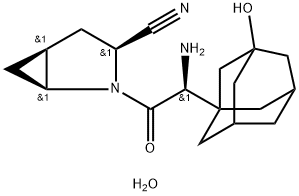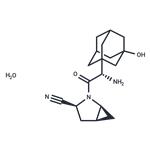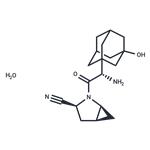While liraglutide targets the incretin system as a GLP-1 analog for
therapeutic intervention in T2DM, saxagliptin enhances GLP-1 plasma concentrations by inhibiting the DPP-4 enzyme responsible for degradation of
GLP-1 by cleavage of the two N-terminal amino acids adjacent to alanine (or
proline), thereby rendering the hormone inactive.
Similarto vildagliptin,
saxagliptin is a cyanopyrrolidine substrate-based inhibitor. The proline
mimetic occupies the small S1-pocket while the nitrile’s trajectory aligns
with the scissile bond of the substrate. The slow dissociation kinetics of
saxagliptin is attributed to a reversible, covalent reaction between the nitrile
and the catalytically active serine hydroxyl (Ser630).
The steric bulk provided by the adamantyl moiety and the constrained cyclopropyl ring stabilizes the trans-rotamer of the amide, thereby preventing the problematic
intramolecular cyclization, via the amino group attacking the nitrile, which
is favored in the cis-conformation.
Since metabolism of saxagliptin is primarily mediated by CYP3A4/5, there is a potential for drug interactions with concomitant administration of strong inducers or inhibitors of these cytochrome P450 enzymes. The most common adverse events (>5% of patients) included upper respiratory tract infection, urinary tract infection, and headache.
Bristol-Myers-Squibb (US)
Saxagliptin Hydrate is a selective and reversible dipeptidyl peptidase-4 (DPP4) inhibitor that may be used to develop treatment for type 2 diabetes.
ChEBI: Saxagliptin hydrate is a hydrate that is the monohydrate form of anhydrous saxagliptin. Used for the treatment of Type II diabetes. It has a role as a hypoglycemic agent and an EC 3.4.14.5 (dipeptidyl-peptidase IV) inhibitor. It contains a saxagliptin.
Saxagliptin (BMS-477118) is an orally active, highly potent and long-acting dipeptidyl peptidase IV inhibitor (human DPP-IV Ki = 0.9 nM; plasma DDP-IV inhibition = 87% 0.5-4h post 4 μmol/kg po. in normal rats) with therapeutic efficacy against type 2 diabetes in vivo (plasma glucose clearance = 28/43/61% post 0.3/1.0/3.0 μmol/kg po. in Zucker fa/fa rats).
Saxagliptin hydrochloride is supplied as a crystalline solid. A stock solution may be made by dissolving the saxagliptin (hydrochloride)in the solvent of choice,which should be purged with an inert gas. Saxagliptin hydrochloride is soluble in organic solvents such as ethanol, DMSO, and dimethyl formamide (DMF). The solubility of saxagliptin hydrochloride in these solvents is approximately 10 mg/ml in ethanol and 20 mg/ml in DMSO and DMF. Further dilutions of the stock solution into aqueous buffers or isotonic saline should be made prior to performing biological experiments. Ensure that the residual amount of organic solvent is insignificant, since organic solvents may have physiological effects at low concentrations. Organic solvent-free aqueous solutions of saxagliptin(hydrochloride)can be prepared by directly dissolving the crystalline solid in aqueous buffers. The solubility of saxagliptin (hydrochloride)in PBS(pH 7.2), is approximately 2 mg/ml. We do not recommend storing the aqueous solution for more than one day.



